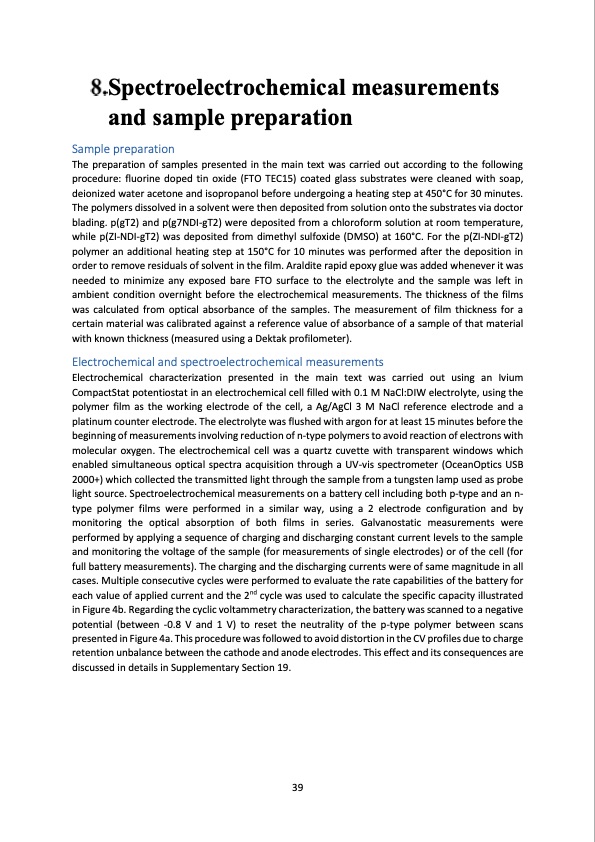
PDF Publication Title:
Text from PDF Page: 039
Spectroelectrochemical measurements and sample preparation Sample preparation The preparation of samples presented in the main text was carried out according to the following procedure: fluorine doped tin oxide (FTO TEC15) coated glass substrates were cleaned with soap, deionized water acetone and isopropanol before undergoing a heating step at 450°C for 30 minutes. The polymers dissolved in a solvent were then deposited from solution onto the substrates via doctor blading. p(gT2) and p(g7NDI-gT2) were deposited from a chloroform solution at room temperature, while p(ZI-NDI-gT2) was deposited from dimethyl sulfoxide (DMSO) at 160°C. For the p(ZI-NDI-gT2) polymer an additional heating step at 150°C for 10 minutes was performed after the deposition in order to remove residuals of solvent in the film. Araldite rapid epoxy glue was added whenever it was needed to minimize any exposed bare FTO surface to the electrolyte and the sample was left in ambient condition overnight before the electrochemical measurements. The thickness of the films was calculated from optical absorbance of the samples. The measurement of film thickness for a certain material was calibrated against a reference value of absorbance of a sample of that material with known thickness (measured using a Dektak profilometer). Electrochemical and spectroelectrochemical measurements Electrochemical characterization presented in the main text was carried out using an Ivium CompactStat potentiostat in an electrochemical cell filled with 0.1 M NaCl:DIW electrolyte, using the polymer film as the working electrode of the cell, a Ag/AgCl 3 M NaCl reference electrode and a platinum counter electrode. The electrolyte was flushed with argon for at least 15 minutes before the beginning of measurements involving reduction of n-type polymers to avoid reaction of electrons with molecular oxygen. The electrochemical cell was a quartz cuvette with transparent windows which enabled simultaneous optical spectra acquisition through a UV-vis spectrometer (OceanOptics USB 2000+) which collected the transmitted light through the sample from a tungsten lamp used as probe light source. Spectroelectrochemical measurements on a battery cell including both p-type and an n- type polymer films were performed in a similar way, using a 2 electrode configuration and by monitoring the optical absorption of both films in series. Galvanostatic measurements were performed by applying a sequence of charging and discharging constant current levels to the sample and monitoring the voltage of the sample (for measurements of single electrodes) or of the cell (for full battery measurements). The charging and the discharging currents were of same magnitude in all cases. Multiple consecutive cycles were performed to evaluate the rate capabilities of the battery for each value of applied current and the 2nd cycle was used to calculate the specific capacity illustrated in Figure 4b. Regarding the cyclic voltammetry characterization, the battery was scanned to a negative potential (between -0.8 V and 1 V) to reset the neutrality of the p-type polymer between scans presented in Figure 4a. This procedure was followed to avoid distortion in the CV profiles due to charge retention unbalance between the cathode and anode electrodes. This effect and its consequences are discussed in details in Supplementary Section 19. 39PDF Image | salt water battery with high stability

PDF Search Title:
salt water battery with high stabilityOriginal File Name Searched:
salt-water-battery.pdfDIY PDF Search: Google It | Yahoo | Bing
Product and Development Focus for Salgenx
Redox Flow Battery Technology: With the advent of the new USA tax credits for producing and selling batteries ($35/kW) we are focussing on a simple flow battery using shipping containers as the modular electrolyte storage units with tax credits up to $140,000 per system. Our main focus is on the salt battery. This battery can be used for both thermal and electrical storage applications. We call it the Cogeneration Battery or Cogen Battery. One project is converting salt (brine) based water conditioners to simultaneously produce power. In addition, there are many opportunities to extract Lithium from brine (salt lakes, groundwater, and producer water).Salt water or brine are huge sources for lithium. Most of the worlds lithium is acquired from a brine source. It's even in seawater in a low concentration. Brine is also a byproduct of huge powerplants, which can now use that as an electrolyte and a huge flow battery (which allows storage at the source).We welcome any business and equipment inquiries, as well as licensing our flow battery manufacturing.| CONTACT TEL: 608-238-6001 Email: greg@salgenx.com | RSS | AMP |